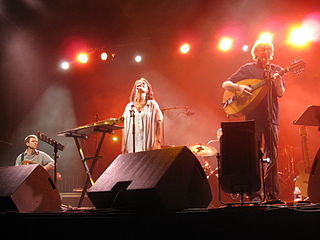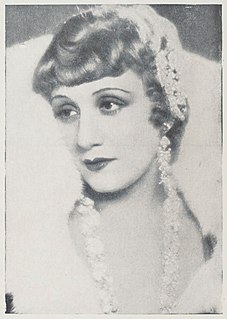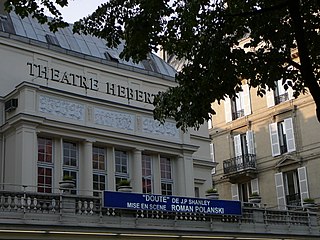
Adolphe Charles Adam was a French composer, teacher and music critic. A prolific composer for the theatre, he is best known today for his ballets Giselle (1841) and Le corsaire (1856), his operas Le postillon de Lonjumeau (1836) and Si j'étais roi (1852) and his Christmas carol "Minuit, chrétiens!".

Jean Raoul Robert Rochefort was a French actor. He received many accolades during his career, including an Honorary César in 1999.

Malicorne are a French folk and folk rock band formed in September 1973 by Gabriel Yacoub, Marie Yacoub, Hughes de Courson and Laurent Vercambre. They flourished in the 1970s, broke up three times in the 1980s but re-formed twice in the early 2010s and toured from July 2012 until their last show in August 2017, after which they broke up.

Henri-Pierre Sauguet-Poupard was a French composer.

Louis-Gaston Ganne was a conductor and composer of French operas, operettas, ballets, and marches.
Denise Rosemonde "Rosine" Delamare was a French costume designer. She was co-nominated for an Academy Award for her work on the film The Earrings of Madame de… (1953).

Le Martyre de saint Sébastien is a five-act musical mystery play on the subject of Saint Sebastian, with a text written in 1911 by the Italian author Gabriele D'Annunzio and incidental music by the French composer Claude Debussy (L.124).
Jonathan Philip Darlington is a British conductor, Music Director Emeritus of the Vancouver Opera and the former Music Director of the Duisburg Philharmonic Orchestra. He is known for his broad repertoire of both opera and symphonic music and appears regularly with major orchestras and opera houses, most notably the Paris Opera, Vienna State Opera, Frankfurt Oper, Orchestre National de France, Prague Radio Symphony Orchestra, the Swedish Chamber Orchestra, Orchestra Sinfonica del San Carlo di Napoli, the Orchestre Philharmonique de Strasbourg, the National Orchestra of Taiwan, the BBC Symphony Orchestra, English National Opera and Opera Australia.

Marie-Claude Georgette Yvonne Pietragalla is a French dancer and choreographer.

Pomone (Pomona) is a pastoral opera in a prologue and five acts by Robert Cambert with a libretto by Pierre Perrin. It has been described as "effectively the first French opera." It was first performed in Paris at the Jeu de Paume de la Bouteille theatre belonging to Cambert and Perrin's Académie d'Opéra on 3 March 1671. The production had ballets choreographed by Des Brosses and sets and machinery designed by Alexandre de Rieux, marquis de Sourdéac. The novelty of the work drew large audiences and the opera enjoyed 146 performances over the eight months of its run. The score of Pomone has only partially survived.

The Théâtre de l'Œuvre is a Paris theatre on the Right Bank, located at 3, Cité Monthiers, entrance 55, rue de Clichy, in the 9° arrondissement. It is commonly conflated and confused with the late-nineteenth-century theater company named Théâtre de l'Œuvre, founded by actor-director-producer Aurélien Lugné-Poe, who would not take control of this performance space until 1919. His company is best known for its earlier phase of existence, before it acquired this theatre venue. From 1893 to 1899, in various Parisian theatres, Lugné-Poe premiered modernist plays by foreign dramatists, as well as new work by French Symbolists, most notoriously Alfred Jarry’s nihilistic farce Ubu Roi, which opened in 1896 at Nouveau-Théâtre.

Gisèle Casadesus was a French actress, who appeared in numerous theatre and film productions. She was an honorary member of the Sociétaires of the Comédie-Française, Grand Officer of the Legion of Honor, Officer of the Ordre des Arts et des Lettres, and Grand-Croix of the National Order of Merit. In a career spanning more than 80 years, Casadesus appeared in more than a dozen films after turning 90.

Vanessa Cailhol is a French actress, dancer and singer, born in Toulouse.
Jules Gressier, (24 June 1897, Roubaix - 27 June 1960, Aix-les-Bains was a French conductor, particularly associated with lyric repertoire and with operetta.

The city of Paris has been an important center for European music since the Middle Ages. It was noted for its choral music in the 12th century, for its role in the development of ballet during the Renaissance, in the 19th century it became famous for its music halls and cabarets, and in the 20th century for the first performances of the Ballets Russes, its jazz clubs, and its part in the development of serial music. Paris has been home to many important composers, including: Léonin, Pérotin, Jean-Baptiste Lully, Jean-Philippe Rameau, Christoph Willibald Gluck, Niccolò Piccinni, Frédéric Chopin, Franz Liszt, Jacques Offenbach, Georges Bizet, Claude Debussy, Maurice Ravel, Hector Berlioz, Paul Dukas, Gabriel Fauré, César Franck, Charles Gounod, Jules Massenet, Vincent d'Indy, Camille Saint-Saëns, Erik Satie, Igor Stravinsky, Sidney Bechet.

Mary Marquet was a French stage and film actress.
Alfred-Adolphe Pasquali was a French actor and theatre director
"What Can I Do?" is a French popular song composed in 1947 by Henri Betti with the lyrics by Édith Piaf. The English lyrics were written in 1949 by Harold Rome.

Jacques Hébertot was the pseudonym of André Daviel. He was a French theater director, poet, journalist and publisher. The Théâtre Hébertot in Paris has been named after him since 1940.
Denise Benoît was a French actress and singer, active across a wide range of genres on the stage, radio and television. Other members of her family were musicians.














